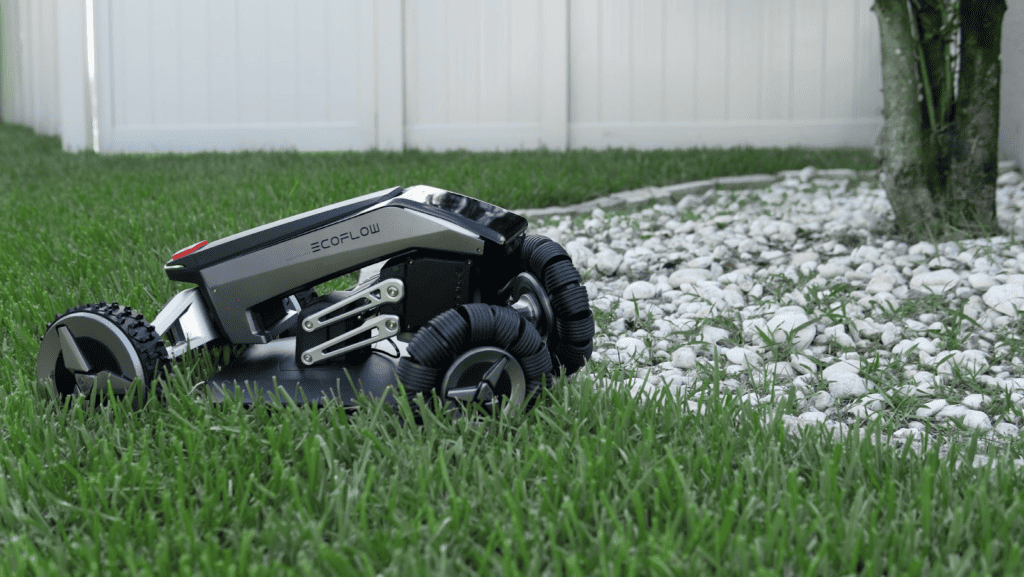Robotic lawn mowers have upended the traditional way of cutting the grass.
Automated mowers seek to eliminate manual labour — and unreliable contractors. The first generation of robotic lawn mowers relied on boundary wires to guide them around your yard, protect landscape features like gardens, and avoid trees and other obstacles.
But do all robot mowers need a perimeter wire? Boundary wires get in the way and create multiple inconveniences — partially defeating the purpose of robotic mowers in the first place.
Learn more about perimeter wires and robotic lawnmowers below and discover the latest generation of AI and LiDAR-powered devices that operate more effectively without requiring perimeter wires.
With a better understanding of the latest innovations, you can buy the right robotic mower to cut the well-manicured lawn of your dreams.

Why Do Most Robotic Mowers Rely on a Boundary Wire?
A robotic lawn mower needs to know where it is and where not to go while trimming your lawn. The first generation of robotic lawn mowers would veer off into course without a perimeter wire — or end up mulching your prized Begonias.
Most robot mowers still use physical boundary wires to operate. The wires act as an invisible fence around the perimeter of your yard. A perimeter wire emits an electromagnetic signal that helps steer the robot mower, guiding it away from flower beds, patios, driveways, and other areas where you don’t want it to roam.
If your landscaping requirements change, boundary wires are movable. But it can be a pain to lay and re-lay them. The whole point of a robotic lawn mower is to eliminate work, not create more of it.
Perimeter wires are also susceptible to damage by animals or lawn/gardening tools, which can unintentionally set your robot lawn mower free.

Do All Robot Mowers Need Boundary Wires?
Not all robot mowers require perimeter wires. Cutting-edge models use new technology like AI and LiDAR to navigate your landscape effortlessly without the hassle of setting up physical boundaries.
Above-ground perimeter wires can be dangerous, presenting a trip hazard for adults and a considerable risk to children who may not see the barrier.
Perimeter wires also deteriorate or break over time as a result of harsh weather conditions. Even limited stretching can damage wires, and corrosion happens no matter where you live.
Perimeter wires also place limitations on installing other systems, like irrigation, aeration, cable or internet connection, or outdoor lighting.
If you accidentally damage a wire when installing any of these systems, the robotic lawn mower won’t be able to do its job effectively until it’s repaired or replaced. You may not even know the damage has occurred until it’s too late.
There are multiple reasons why a robotic lawn mower that doesn’t rely on perimeter wires is more convenient and efficient.
Luckily, new innovations have put wire-free robotic lawn mowers, like EcoFlow’s award-winning BLADE, well within reach.
How Do Robotic Mowers Operate Without a Perimeter Wire?
Robotic lawn mowers are revolutionising the “chore” of landscaping. Especially with advanced models now emerging that don’t rely on perimeter wires or other physical boundaries.
Smart robotic mowers like the BLADE rely on technologies like GPS, visual sensors, and LiDAR for navigation.
Wireless robotic mowers allow homeowners like you to enjoy a well-manicured lawn without installing or maintaining boundary wires.
GPS
Robot mowers with GPS capabilities rely on satellites to find their way around the yard, mapping out a layout and storing it for future use. Next-gen automated mowers don’t need boundary wires to tell them where they can and can’t go.
EcoFlow’s BLADE Robotic Lawnmower harnesses GPS to create highly precise cutting patterns within 2cm of the designated boundary. You can set the mower’s perimeters in several ways, including selecting a cross-region and dividing prohibited areas.
Sensors
Advanced mowers can include a combination of proximity, humidity, and visual sensors — in addition to LiDAR — to detect obstacles, lawn edges, and other landscape features.
Sensors can distinguish between surfaces like grass and pavement and navigate around obstacles and areas you wish to protect.
But not all sensors are created equal. By incorporating AI, machine learning, and newly available LiDAR technology, Smart Devices like BLADE can make up for what older mowers lack in accuracy.
Beacon Technology
Beacon technology works with a combination of GPS and sensors. By placing beacon units around your yard, you can create an invisible boundary that the robot mower’s sensors detect. What it creates is similar to a more accurate and localised version of GPS.
Beacon technology is also popular with robot vacuums. These products have shown great success working indoors. We may soon see more outdoor versions designed to handle tasks like mowing lawns.
Vision-Based Systems
Vision-based sensors are one of the most advanced technologies available for lawn mowing.
BLADE robots use visual sensors, LiDAR and proprietary machine learning algorithms to navigate and mow your lawn with optimal efficiency. The combined system is called X-Vision.
X-Vision takes visual cues from the environment to build a map of its operating area.
Similar to autonomous cars, X-Vision intelligently combines information gathered from various systems to maximize performance.

Benefits of Using Robotic Lawnmowers Without Boundary Wires
Robotic mowers that don’t require boundary wires offer several advantages, from less room for error to less time and effort needed. What’s not to love?
Less Room for Human Error
With GPS, sensors, beacon technology, and vision-based systems, the human error that can result from boundary wire placement is eliminated. Advanced robot mowers like the BLADE will use proprietary technology to stay within the boundaries you define.
No Need to Repair or Replace Boundary Wires
Robot mowers that require boundary wires often leave the wires exposed to the elements, where they can easily be damaged. With a wireless robotic mower, these worries are gone. No boundary wires to install means there are also none to replace.
Less Time and Effort Required
Using wireless technology saves time and effort in laying down any wire around your yard. It prevents unnecessary use of the robot mower.
Since the goal of a robot lawn mower is to handle the work for you, one that doesn’t require preliminary work stays true to that claim.
Removes Safety Hazards and Accessibility Issues
Boundary wires may prevent tripping hazards if not installed correctly. It can be a serious issue in high-traffic areas or yards where children or animals play.
Setting the perimeters requires several steps, and the labour involved also can be intensive. For people with disabilities or limited mobility, the additional step creates accessibility issues where there doesn’t need to be any.

Frequently Asked Questions
Are There Robot Lawn Mowers That Don’t Use Perimeter Wires?
Yes, robotic lawn mowers like the BLADE Robot Lawn Mower from EcoFlow don’t require perimeter wires. Instead, these mowers use GPS, sensors, beacons, or vision systems to detect the designated boundaries and avoid mowing them.

Final Thoughts
Robot lawnmowers can make lawn maintenance more manageable and efficient than ever. By leveraging technology like GPS, sensors, beacon systems, and vision-based systems, wireless robotic mowers can simplify your work even more by removing the need to install boundary wires.If you’re looking for a more intelligent and easier way to maintain your lawn, consider investing in a robot mower that doesn’t require any boundary wires. EcoFlow’s BLADE operates using a virtual boundary and high-precision GPS for a smart, wireless solution to lawn care.


